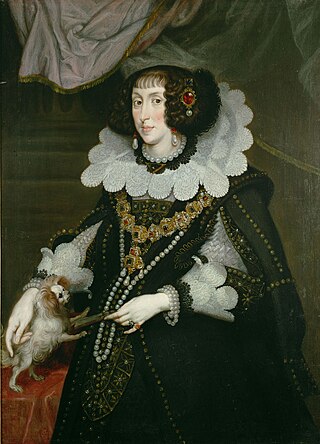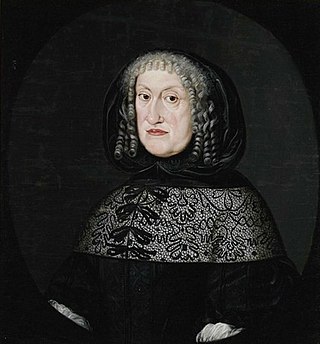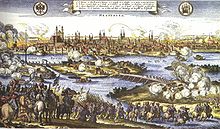The House of Ascania was a dynasty of German rulers. It is also known as the House of Anhalt, which refers to its longest-held possession, Anhalt.

Matthäus Merian der Ältere was a Swiss-born engraver who worked in Frankfurt for most of his career, where he also ran a publishing house. He was a member of the patrician Basel Merian family.

The Battle of White Mountain was an important battle in the early stages of the Thirty Years' War. It led to the defeat of the Bohemian Revolt and ensured Habsburg control for the next three hundred years.

Zerbst is a town in the district of Anhalt-Bitterfeld, in Saxony-Anhalt, Germany. Until an administrative reform in 2007, Zerbst was the capital of the former Anhalt-Zerbst district.

The sack of Magdeburg, also called Magdeburg's Wedding or Magdeburg's Sacrifice, was the destruction of the Protestant city of Magdeburg on 20 May 1631 by the Imperial Army and the forces of the Catholic League, resulting in the deaths of around 20,000, including both defenders and non-combatants. The event is considered the worst massacre of the Thirty Years' War. Magdeburg, then one of the largest cities in Germany, having well over 25,000 inhabitants in 1630, did not recover its importance until well into the 18th century.

Archduchess Maria Anna of Austria, was a German regent, Electress of Bavaria by marriage to Maximilian I, Elector of Bavaria, and co-regent of the Electorate of Bavaria during the minority of her son Ferdinand Maria, Elector of Bavaria from 1651 to 1654.

Anhalt-Köthen was a principality of the Holy Roman Empire ruled by the House of Ascania. It was created in 1396 when the Principality of Anhalt-Zerbst was partitioned between Anhalt-Dessau and Anhalt-Köthen. The first creation lasted until 1562, when it fell to Prince Joachim Ernest of Anhalt-Zerbst, who merged it into the reunited Principality of Anhalt.

Onno Klopp was a German historian, best known as the author of Der Fall des Hauses Stuart, the fullest existing account of the later Stuarts. He is also known as one of the few German historians who denigrated Frederick the Great.

Gommern is a town in the Jerichower Land district, in Saxony-Anhalt, Germany. It is situated approximately 15 km (9 mi) southeast of Magdeburg. On January 1, 2005, the municipalities Dannigkow, Dornburg, Karith, Ladeburg, Leitzkau, Menz, Nedlitz, Vehlitz and Wahlitz have been incorporated into Gommern. On January 1, 2008, Prödel was incorporated, and on January 1, 2009, Lübs was incorporated.
The Treaty of Hamburg, signed on 5 March 1638 was the ratification of the important Treaty of Wismar a full two years after it had been negotiated by Cardinal Richelieu of France and representatives of Queen Christina of Sweden. As it provided the Swedes with crucial funds to go on the offensive again, it was a major turning point of the Thirty Years' War.
Sigismund I, Prince of Anhalt-Dessau, was a German prince of the House of Ascania and ruler of the principality of Anhalt-Zerbst until 1396, when he became the first ruler of the principality of Anhalt-Dessau. He was the eldest son of John II, Prince of Anhalt-Zerbst, by his wife Elisabeth, daughter of John I, Count of Henneberg-Schleusingen.
Albert IV, Prince of Anhalt-Köthen, was a German prince of the House of Ascania and ruler of the principality of Anhalt-Zerbst until 1396, when he became the first ruler of the principality of Anhalt-Köthen.
George I, Prince of Anhalt-Dessau, was a German prince of the House of Ascania and ruler of the principality of Anhalt-Dessau. He was the second son of Sigismund I, Prince of Anhalt-Dessau, by his wife Judith, daughter of Gebhard XI, Count of Querfurt.

Joachim Ernest of Anhalt, was a German prince of the House of Ascania, ruler of the principality of Anhalt-Zerbst from 1551, and from 1570 sole ruler of all the Anhalt lands.

Eleonore of Anhalt-Zerbst was a member of the House of Ascania and a princess of Anhalt-Zerbst by birth and by marriage Duchess of Schleswig-Holstein-Sonderburg-Norburg.

The Kemper Werth is a promontory in the Rhine at the mouth of the River Sieg, in the northeast of Bonn, in Germany. Formerly a pair of islands, it became attached to the river bank as a result of engineering work altering the confluence of the Sieg. It was the site of a fort during the Eighty Years' War and is now part of a protected natural area, the Naturschutzgebiet Siegaue.

The naval war on Lake Constance was a series of conflicts that took place on Lake Constance, beginning in 1632, in the context of the Thirty Years' War. At that time various powers ruled different parts of the shoreline: in the north and east was Roman Catholic, Habsburg Anterior Austria; in the northwest and west the troops of the Protestant Duchy of Württemberg with their allies from Kingdom of Sweden and Kingdom of France. These various powers sought, for strategic reasons, to exercise their hegemony over the area of Lake Constance. Only the partly Catholic and partly Protestant southern shore which belonged to the Old Swiss Confederacy maintained an uneasy neutrality due to their divided loyalties.
Matthias Asche is a German historian specialising in the early modern period.
Hans Medick is a German historian.
The Second Battle of Breitenfeld was a major engagement of the Thirty Years' War between the Imperial Army of the Holy Roman Empire under Archduke Leopold Wilhelm of Austria and Ottavio Piccolomini, supported by Saxon troops, and the Swedish Army under Lennart Torstensson. It was the last battle of the war featuring more than 20.000 soldiers on each side and one of the rare occasions where both combatants were attacking.














